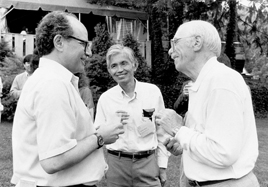1987: Evolution of Catalytic Function, Vol. LII
Organizer: James Watson
For all too long, RNA never had the essential simplicity we wanted from it. Unlike DNA, the closer we got to it, the more complex it seemed. Initially, we focused on its informational properties, postulating that it carried the genetic information from DNA to the cytoplasmic sites of protein synthesis. It then seemed natural to believe that the main RNA molecules within ribosomes were the templates for the ordering of amino acids during protein synthesis. Quickly, however, this idea was overturned with the discovery first of transfer RNA and then of the true templates, messenger RNA itself. These seminal discoveries had the positive impact of permitting the basic outlines of protein synthesis to be established, as well as permitting the elucidation of the genetic code. At the same time, the dilemma arose of why RNA played so many different roles. In some profound way, the explanation had to lie in the molecular events that gave rise to the origin of life.
Rationally thinking about events so distant in the past, however, was then and still is a major intellectual challenge. Francis Crick rose to the occasion by postulating that RNA had to have an enzymatic role, as well as template and structural roles, functioning during the early stages of life as the enzyme for its own self-replication. Under this scheme, the first genetic molecule was RNA, with DNA coming later, after the essential outlines of the genetic code were established. But logical as this idea was, it had little impact, and for almost 20 years, thinking about the origin of life was regarded at best as a safe haven for minds unable to keep up with the extraordinary rush of a recombinant-DNA-driven assault on the nature of life as it exists today.
Then in 1982, the discovery of the first example RNA self-splicing suddenly led to the realization that RNA molecules do have the capability to act as catalysts. Over the past several years, many more examples of self-splicing have been found, and the fact that the catalytic activity of RNase P resides in its RNA component has been demonstrated. With Crick's conjecture now a fact and with the recent rapid progress in understanding today's enzymes and ribosomes, the time had thus arrived to bring together a diverse collection of pure chemists, biochemists,
| 
molecular biologists, and evolutionary biologists to discuss the evolutionary events that may have given rise to the living organisms that now exist on earth. As a title, we chose the Evolution of Catalytic Function to help assure that this Symposium would bring together minds that think in terms of chemistry, as well as about genetic information.
The first plans for this our 52nd Symposium arose at a meeting at Harvard in August 1986 between Walter Gilbert, Jeremy Knowles, and myself. Subsequently, I greatly benefited from suggestions given by Leslie Orgel, Daniel Koshland, Russell Doolittle, Tom Cech, and Jim Darnell. The final program comprised 110 speakers, each speaking some 30 minutes. These presentations led to one of our intellectually most demanding meetings, since the talks were arranged to be longer than customary in view of the very diverse nature of the audience, which this year consisted of some 167 scientists. The majority of this year's attendees presented papers, resembling the situation in the very first Symposia. At its start, I worried that our program might be too wide-ranging for true intellectual exchanges. But by the end, I was more than pleased by the high spirits expressed by virtually all participants, who felt that this was a truly historic gathering in which the need to think evolutionary had at last become an accepted way of thinking for molecular biologists. Helping assure this success were the wide-ranging opening talks by Daniel Koshland, Leslie Orgel, and Manfred Eigen as well as the gracefully lucid summary by Alan Weiner.
— Jan A. Witkowski |